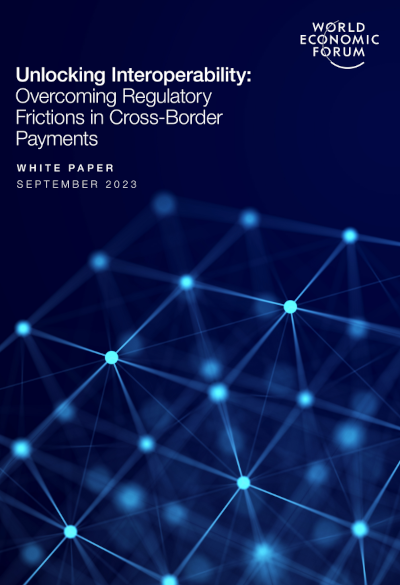Introduction
In the realm of global finance, the landscape of cross-border payments is evolving rapidly, driven by technological advancements and the increasing demand for seamless, cost-effective transactions. However, regulatory frictions have emerged as a significant hurdle, hindering the efficiency and transparency of cross-border payments.
The World Economic Forum’s report on “”Unlocking Interoperability: Overcoming Regulatory Frictions in Cross-Border Payments” delves deep into these challenges and proposes solutions to foster regulatory harmony in the cross-border payment ecosystem.
The Evolution of Cross-Border Payments
The report highlights the evolution of cross-border payments, emphasizing the role of central banks in experimenting with digital currencies and fast payment systems. Despite technological advancements, cross-border payments still face inefficiencies in processing times, costs, and regulatory complexities.
The demand for seamless, safe, and cost-effective cross-border payments is outpacing regulators’ ability to establish a globally coordinated regulatory framework.

Regulatory Challenges in Cross-Border Payments
Regulatory frameworks play a crucial role in shaping the landscape of cross-border payments. The report underscores the challenges posed by divergent regulations, high compliance costs, and the need to adhere to multiple regulatory requirements across jurisdictions. The lack of regulatory interoperability hampers the efficiency and inclusivity of cross-border payment systems, leading to prolonged processing times and increased costs for businesses and consumers.
The four most significant regulatory frictions and challenges faced by both banks and non-bank payment service providers (PSPs) in the cross-border payments landscape are:
-
Differences in Regulatory and Oversight Frameworks:
- Inconsistent or unaligned legal, regulatory, and supervisory frameworks can create challenges in cross-border payments.
- Disparities in licensing requirements, consumer protection regulations, AML/CFT measures, data privacy laws, and transaction monitoring standards can arise.
- Regulatory uncertainty hinders market entry, creates loopholes for regulatory arbitrage, and increases compliance costs.
- The correlation between increased regulation and regulatory divergence impacts financial performance and business expansion
-
Compliance with AML/CFT Requirements:
- The current AML/CFT regime poses challenges for correspondent banks operating internationally.
- Varying implementation of FATF guidelines leads to inconsistency in AML compliance requirements across jurisdictions.
- Stringent enforcement and fear of non-compliance consequences result in de-risking practices, limiting access to cross-border payment services.
- Financial institutions face rising compliance costs due to increasing AML regulations and complex investigations
-
Data Privacy and Security Regulations:
- Data-related regulatory frameworks, including data privacy, security, and localization requirements, impact PSP operations in cross-border transactions.
- Conflicts between data regulations and financial rules can hinder information sharing crucial for supervision and risk management.
- Data localization requirements may restrict data transfer, leading to delays and increased costs in cross-border payments.
- Regulators face challenges balancing data protection with transparency and monitoring for AML/CFT compliance.
-
Regulatory Barriers to Accessing Payment Systems and Infrastructure:
- Non-bank PSPs face regulatory obstacles in accessing domestic payment systems, limiting their participation.
- Regulations may exclude non-bank PSPs from payment systems or set eligibility requirements that they cannot meet.
- Limited access to payment systems increases intermediaries in transactions, raising pre-funding costs and hindering market competition.
These challenges highlight the need for regulatory harmonization, collaboration among regulators, and a balance between regulatory requirements and efficient cross-border payment operations.
Impact of Regulatory Divergence on Financial Performance
The correlation between increased regulation and regulatory divergence is a pressing concern for financial institutions. The report cites a study by the OECD and IFAC, revealing that regulatory inconsistencies have a considerable impact on financial performance and act as barriers to expanding business into new jurisdictions.
Compliance with anti-money laundering/combating the financing of terrorism (AML/CFT) requirements presents a conundrum for correspondent banks, leading to de-risking and exclusion of certain populations from accessing cross-border payment services.
Recommendations for Regulatory Interoperability
To address the regulatory frictions in cross-border payments, the report proposes a set of recommendations aimed at improving regulatory interoperability.
These recommendations include making efficiency and inclusion a key objective, strengthening regulatory cooperation, modernizing regulations, and fostering public-private partnerships. By prioritizing areas of regulatory friction and promoting regulatory harmonization, regulators can enhance the effectiveness, safety, and equity of cross-border payment systems.
Conclusion
In conclusion, the report on Unlocking Interoperability in Cross-Border Payments sheds light on the challenges and opportunities in the global payment ecosystem. By addressing regulatory frictions, enhancing regulatory cooperation, and modernizing regulatory frameworks, stakeholders can pave the way for a more efficient and inclusive cross-border payment system.
The key takeaway from this report is the urgent need for regulatory harmonization to unlock the full potential of cross-border payments and drive global economic growth.

Leave a Reply